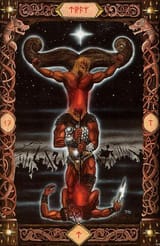Search Results
6/27/2025, 4:45:11 PM
>>17795786
>Analyzing the vocabulary of irminsul, the prefix '*irmin-' or '*ermin-', which is derived from the Proto-Germanic word '*ermunaz', meaning 'strong' or 'great', is derived from the meaning of 'furrow' or 'plow'. It is a combination of '-sul'. '*irmin-' is presumed to have the same etymology as 'jormun-' in Old Norse. Irmin was also the name of one of the gods and gods of war worshiped by the ancient Saxons, which was also identified with Odin, the god of war, or Tyr, the god of war in Norse. In light of these myths, it is possible that irminsul was a religious symbol related to irmin
>In the Old Saxon baptismal vow, the newly baptized Saxons worshipped their ancient gods, which the Saxons had to renounce. In the ancestral table of the kings of Essex in England, the Saxon god is the Soo von Wóden, and thus he can be considered the forefather of the Saxons. His name means either "Gnosis of the Saxon" or "Sword Gnosis," since a Sax is the name for the knight's sword. Thus, he is synonymous with the war and tribal god *Tiu woorschinli
>However, representatives of the three-function system assume that Saxnot belonged to the third function and therefore must have been a fertility god
>It is likely that Tiw (Tyr) was the original “irmin- god,” the greatest of the gods, to whom the Saxon Irminsul (Irmin-Pillar) was dedicated. On the daily human level, the Irminsul is embodied by the house-pillars; on the cosmic level it is the World-Tree, which preserves the levels of being by holding them apart and at the same time, as the central axis of the universe, connects them; and this is shown in the shape of the rune tiwaz, which can be interpreted either as the spear or as the pillar holding up the heavens. In the Old High German “Hildebrantslied,” the warrior Hildebrant calls upon “irmingot” (“the Irmin-god”) and “waltant got” (“the ruling god”) to witness the terrible fate which “Woe-Wyrd” has wrought for him
>Analyzing the vocabulary of irminsul, the prefix '*irmin-' or '*ermin-', which is derived from the Proto-Germanic word '*ermunaz', meaning 'strong' or 'great', is derived from the meaning of 'furrow' or 'plow'. It is a combination of '-sul'. '*irmin-' is presumed to have the same etymology as 'jormun-' in Old Norse. Irmin was also the name of one of the gods and gods of war worshiped by the ancient Saxons, which was also identified with Odin, the god of war, or Tyr, the god of war in Norse. In light of these myths, it is possible that irminsul was a religious symbol related to irmin
>In the Old Saxon baptismal vow, the newly baptized Saxons worshipped their ancient gods, which the Saxons had to renounce. In the ancestral table of the kings of Essex in England, the Saxon god is the Soo von Wóden, and thus he can be considered the forefather of the Saxons. His name means either "Gnosis of the Saxon" or "Sword Gnosis," since a Sax is the name for the knight's sword. Thus, he is synonymous with the war and tribal god *Tiu woorschinli
>However, representatives of the three-function system assume that Saxnot belonged to the third function and therefore must have been a fertility god
>It is likely that Tiw (Tyr) was the original “irmin- god,” the greatest of the gods, to whom the Saxon Irminsul (Irmin-Pillar) was dedicated. On the daily human level, the Irminsul is embodied by the house-pillars; on the cosmic level it is the World-Tree, which preserves the levels of being by holding them apart and at the same time, as the central axis of the universe, connects them; and this is shown in the shape of the rune tiwaz, which can be interpreted either as the spear or as the pillar holding up the heavens. In the Old High German “Hildebrantslied,” the warrior Hildebrant calls upon “irmingot” (“the Irmin-god”) and “waltant got” (“the ruling god”) to witness the terrible fate which “Woe-Wyrd” has wrought for him
Page 1
